Display Aircraft
DISPLAY AIRCRAFT
Last update: 10-8-23 at 05:09 PM CT
In addition to the amazing USAF Thunderbirds and F-35 Lightning II Demo Team and other aircraft, you will see some of the best civilian and military pilots in the world – flying for you. Plus, one of the largest displays of civilian & military aircraft in North America (75+ planes).
Important Note on the Warbird Display Ramp
Some aircraft below are on the WARBIRD DISPLAY RAMP. Display times will vary. If you’d like to see these aircraft … please arrive early!
Please note: Aircraft below might not be the exact paint scheme shown. All display aircraft are subject to change without notice. Please check back the week of the show for the most up-to-date list of 2023 aircraft. Updates will be made as aircraft are confirmed. We will update this page throughout the summer. Keep an eye out for more details.
Please note: All displays and participating aircraft are subject to change due to operational requirements, national weather conflicts etc.
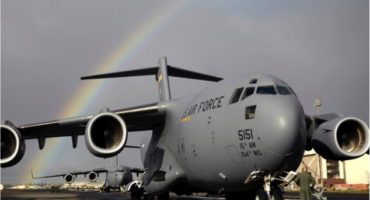
C-17 Globemaster III
“The C-17 Globemaster III is the newest, most flexible cargo aircraft to enter the airlift force. The C-17 is capable of rapid strategic delivery of troops and all types of cargo to main operating bases or directly to forward bases in the deployment area. The aircraft can perform tactical airlift and airdrop missions and can transport litters and ambulatory patients during aeromedical evacuations when required. The inherent flexibility and performance of the C-17 force improve the ability of the total airlift system to fulfill the worldwide air mobility requirements of the United States.”
Source/Link: http://www.af.mil/AboutUs/FactSheets/
Display/tabid/224/Article/104523/c-17-globemaster-iii.aspx
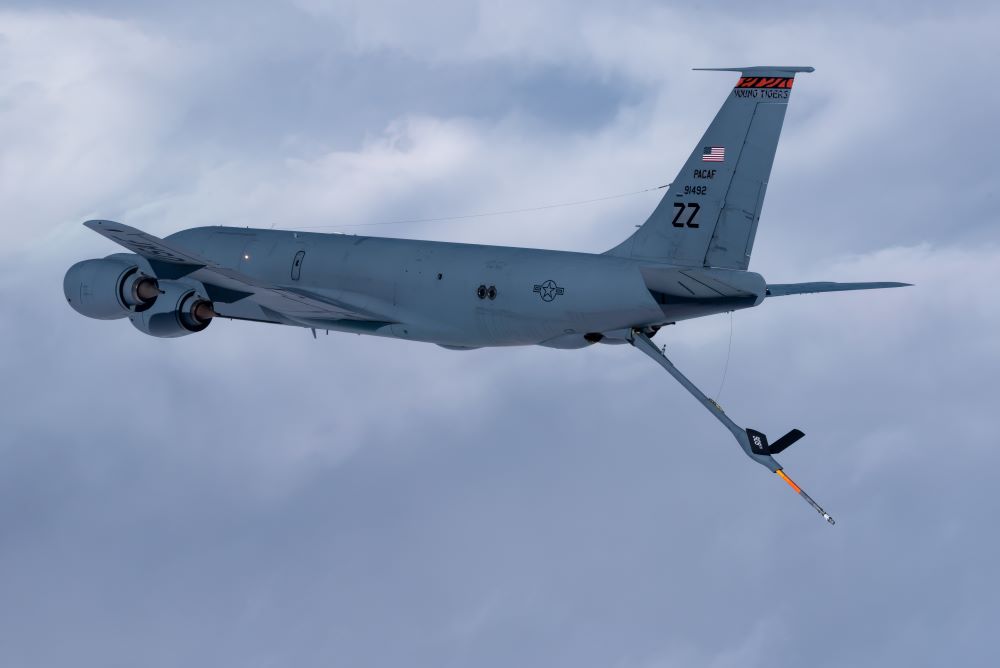
Boeing KC-135 Stratotanker
www.af.mil/About-Us/Fact-Sheets/Display/Article/1529736/kc-135-stratotanker/
Mission
The KC-135 Stratotanker provides the core aerial refueling capability for the United States Air Force and has excelled in this role for more than 60 years. This unique asset enhances the Air Force’s capability to accomplish its primary mission of global reach. It also provides aerial refueling support to Air Force, Navy, Marine Corps and allied nation aircraft. The KC-135 is also capable of transporting litter and ambulatory patients using patient support pallets during aeromedical evacuations.
Features
Four turbofans, mounted under 35-degree swept wings, power the KC-135 to takeoffs at gross weights of up to 322,500 pounds. A cargo deck above the refueling system can hold a mixed load of passengers and cargo. Depending on fuel storage configuration, the KC-135 can carry up to 83,000 pounds of cargo.
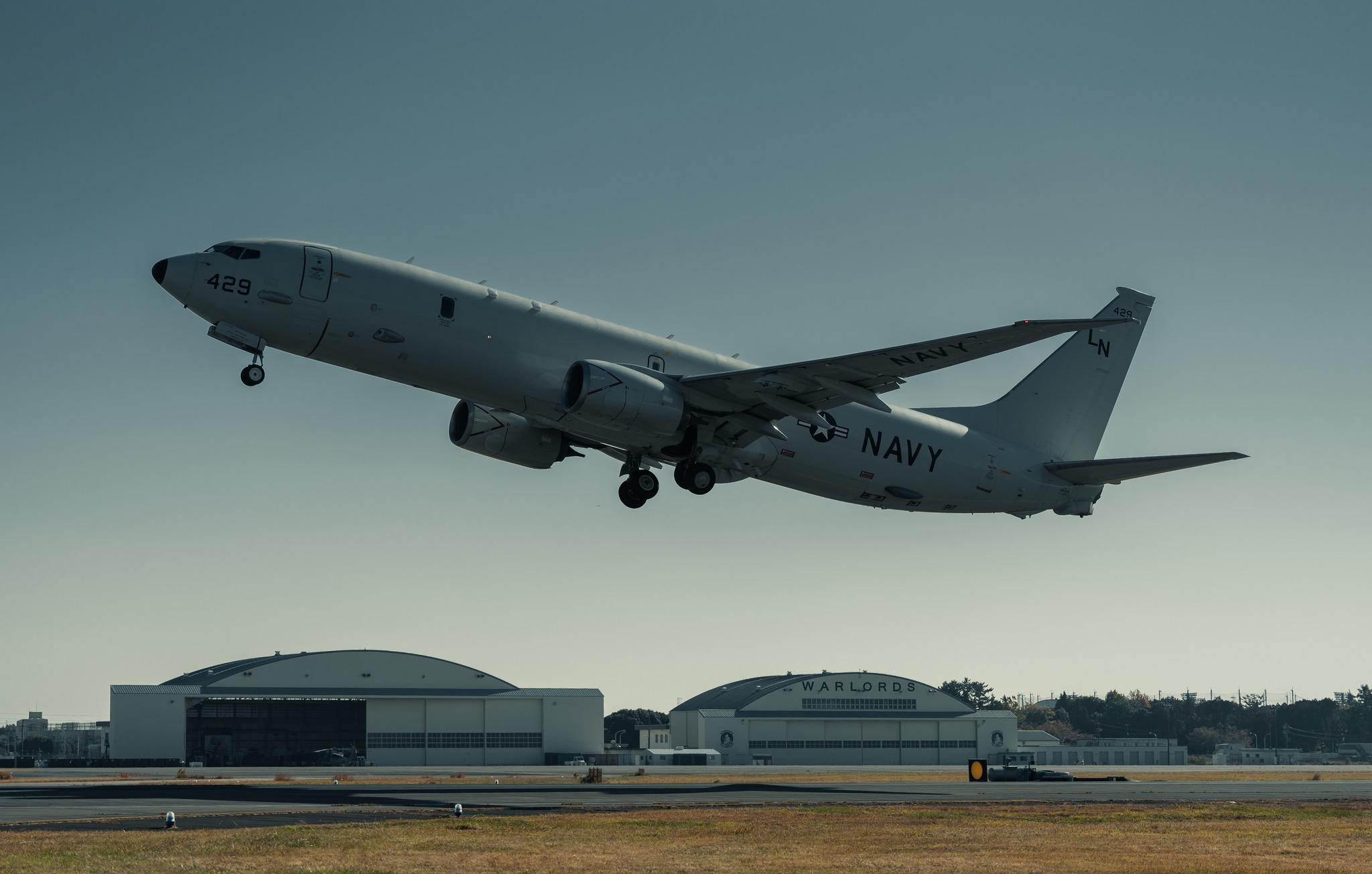
P-8 Poseidon
The Boeing P-8 Poseidon (formerly the Multimission Maritime Aircraft or MMA) is a military aircraft developed for the United States Navy (USN). The aircraft has been developed by Boeing Defense, Space & Security, modified from the 737-800ERX.
The P-8 conducts anti-submarine warfare (ASW), anti-surface warfare (ASUW), and shipping interdiction, along with an electronic signals intelligence (ELINT) role. This involves carrying torpedoes, depth charges, Harpoon anti-ship missiles, and other weapons. It is able to drop and monitor sonobuoys. It is designed to operate in conjunction with the Northrop Grumman MQ-4C Triton Broad Area Maritime Surveillance unmanned aerial vehicle. The aircraft has been ordered by the Indian Navy as the P-8I Neptune, Royal Australian Air Force, and Royal Air Force.
Credit/Source:
https://en.wikipedia.org/wiki/Boeing_P-8_Poseidon
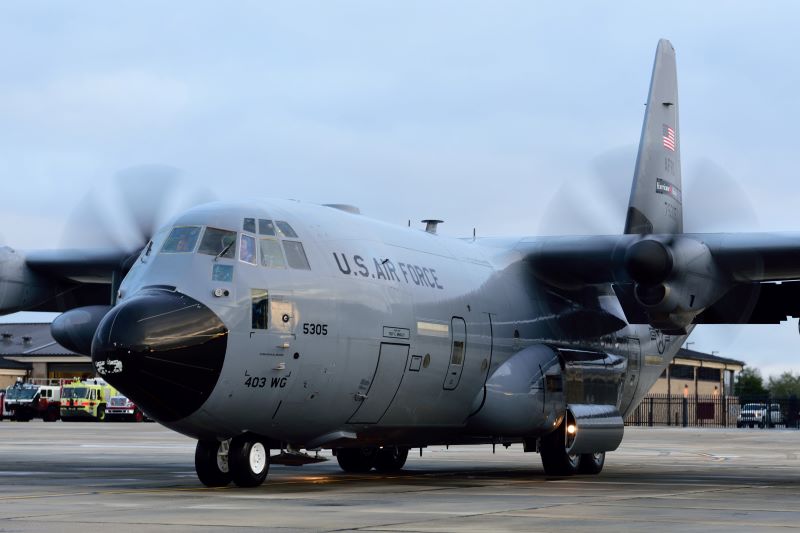
WC-130 Hercules
www.af.mil/About-Us/Fact-Sheets/Display/Article/104561/wc-130-hercules/
Mission
The WC-130 Hercules is a high-wing, medium-range aircraft flown by the Air Force Reserve Command for weather reconnaissance missions. The aircraft penetrates tropical disturbances and storms, hurricanes and winter storms to obtain data on movement, size and intensity. The WC-130J is the weather data collection platform for the 53rd Weather Reconnaissance Squadron located at Keesler Air Force Base, Miss.
Features
The WC-130J is a C-130J transport configured with palletized weather instrumentation that collects weather data, and is capable of staying aloft almost 18 hours at an optimum cruise speed of more than 300 mph.
The WC-130 provides vital tropical cyclone forecasting information. It penetrates tropical cyclones and hurricanes at altitudes ranging from 500 to 10,000 feet (151.7 to 3,033.3 meters) above the ocean surface depending upon the intensity of the storm.
An average weather reconnaissance mission might last 11 hours and cover almost 3,500 miles while the crew collects and reports weather data. The WC-130J carries a minimal crew of five: pilot, co-pilot, navigator, aerial reconnaissance weather officer and weather reconnaissance loadmaster.
The aircraft is equipped with two external 1,400 gallon (5,320-liter) fuel tanks and an internal 1,800 gallon (6,480 liter) fuel tank.
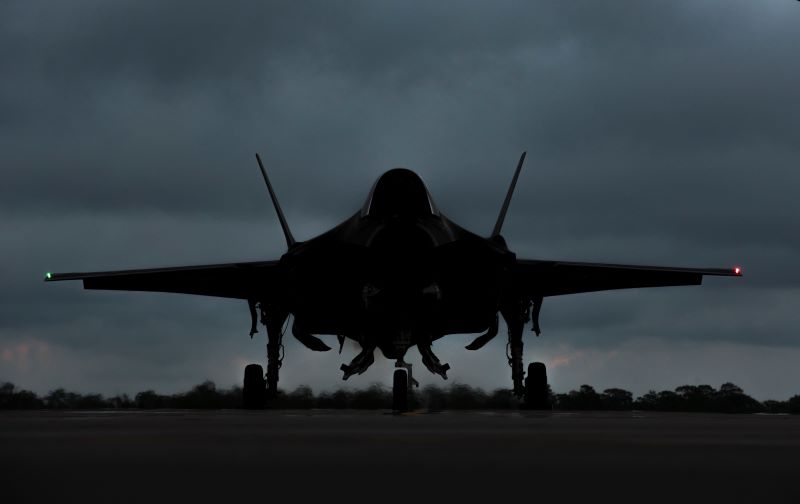
33rd Fighter Wing Eglin AFB - F-35A Lightning II
www.33fw.af.mil/About-Us/Fact-Sheets/Article/885702/33rd-fighter-wing/
Two F-35A Lightning II display aircraft will be on the ramp from Eglin AFB
The 33rd Fighter Wing “Nomads,” a graduate flying and maintenance training wing for the F-35A Lightning II, is organized under 19th Air Force, Air Education and Training Command. It is a tenant unit on Eglin Air Force Base, Florida, which is an Air Force Materiel Command base. The wing has two geographically separated units at Tyndall Air Force Base and Hurlburt Field, Florida.
Commander
Col. David M. Skalicky
Mission
Train and transform combat-credible Airmen for America
Vision
Ready to win…Wherever Nomads roam
Personnel and Resources
The 33rd FW mission is accomplished by over 1,300 assigned U.S. military, government civilian, and contract personnel. Annual student training yields on average 59 F-35 pilots, 1,500 F-35 A/B/C maintainers, 140 intelligence personnel in support of Air Force Special Operations Forces, 60 intelligence personnel in support of F-35 operations and 150 air battle managers in support of Air Force operations. The first F-35A aircraft in support of U.S. Air Force, Navy, and Marine pilot training arrived on July 14, 2011. The wing is authorized 59 F-35A models. The F-35A is a conventional takeoff and landing, low-observable, multi-role fighter aircraft equipped with fifth generation sensors that provide it unparalleled situational awareness making this weapons system optimized to sustain air superiority and execute air interdiction and close air support as part of the DoD fleet.
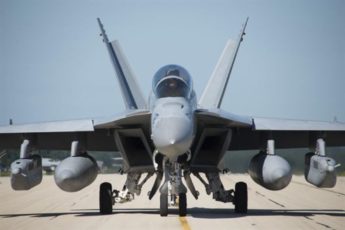
EA-18G Growler from NAS Whidbey
cnrnw.cnic.navy.mil/Installations/NAS-Whidbey-Island/About/Aviation-Commands/Electronic-Attack-Wing/
NAS Whidbey Island is home to the majority of the Navy’s VAQ squadrons flying the EA-18G Growler, an all-weather, electronic attack aircraft with the primary role of suppressing enemy air defense systems.
There are 12 operational Navy electronic attack squadrons at Whidbey and one operational squadron, VAQ-141, permanently forward deployed to the Western Pacific on board USS Ronald Reagan (CVN 76), home ported in Japan. Each squadron typically has four aircraft assigned and averages 30 officers and 170 enlisted personnel.
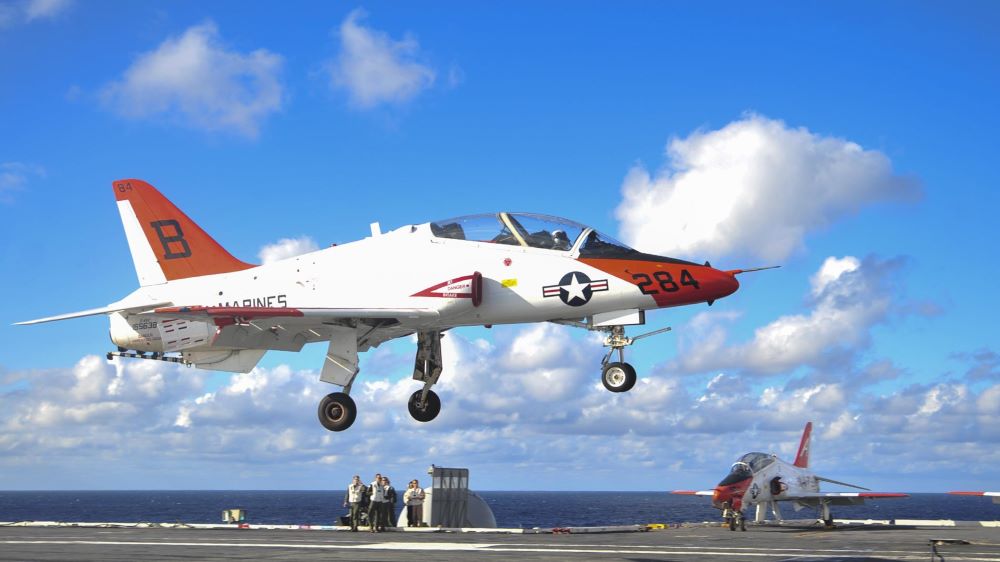
T-45 Goshawk
www.navair.navy.mil/product/T-45-Goshawk-0
The T-45A aircraft, the Navy version of the British Aerospace Hawk aircraft, is used for intermediate and advanced portions of the Navy/Marine Corps pilot training program for jet carrier aviation and tactical strike missions. The T-45A has replaced the T-2 Buckeye trainer and the TA-4 trainer with an integrated training system that includes the T-45A Goshawk aircraft, operations and instrument fighter simulators, academics, and training integration system. There are two versions of T-45 aircraft currently in operational use at this time, the T-45A and T-45C derivatives. The T-45A, which became operational in 1991, contains an analog design cockpit while the new T-45C (began delivery in December 1997) is built around a new digital “glass cockpit” design.
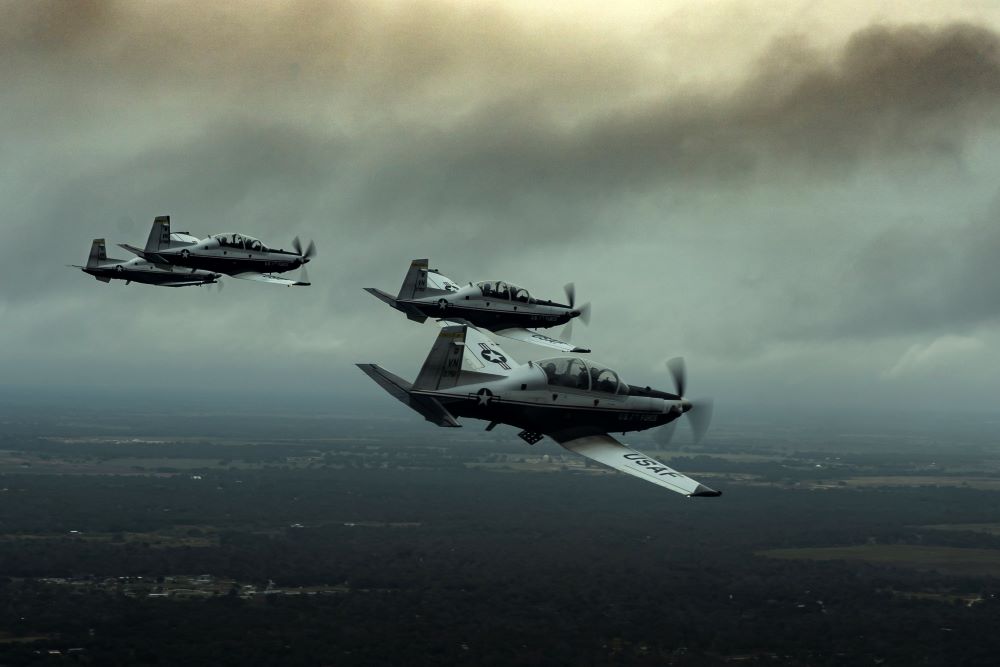
T-6A Texan II
www.af.mil/About-Us/Fact-Sheets/Display/Article/104548/t-6a-texan-ii/
Mission
The T-6A Texan II is a single-engine, two-seat primary trainer designed to train Joint Primary Pilot Training, or JPPT, students in basic flying skills common to U.S. Air Force and Navy pilots.
Features
Produced by Raytheon Aircraft, the T-6A Texan II is a military trainer version of Raytheon’s Beech/Pilatus PC-9 Mk II.
Stepped-tandem seating in the single cockpit places one crewmember in front of the other, with the student and instructor positions being interchangeable. A pilot may also fly the aircraft alone from the front seat. Pilots enter the T-6A cockpit through a side-opening, one-piece canopy that has demonstrated resistance to bird strikes at speeds up to 270 knots.
The T-6A has a Pratt & Whitney Canada PT6A-68 turbo-prop engine that delivers 1,100 horsepower. Because of its excellent thrust-to-weight ratio, the aircraft can perform an initial climb of 3,100 feet (944.8 meters) per minute and can reach 18,000 feet (5,486.4 meters) in less than six minutes.
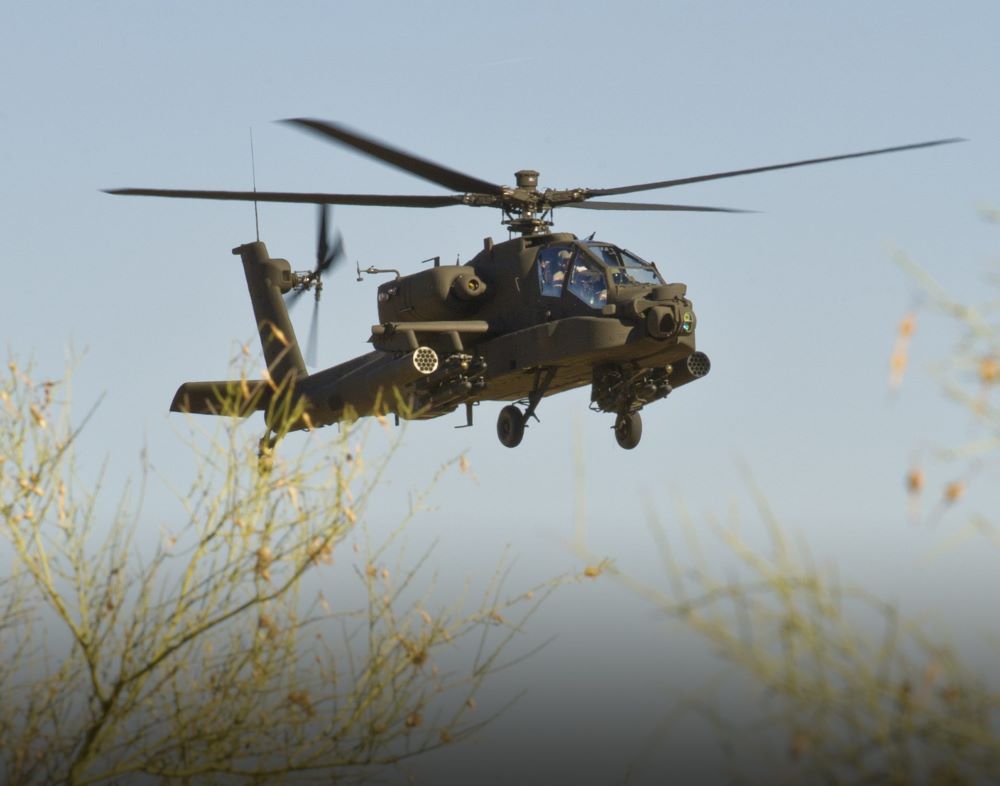
U.S. Army's AH-64D/E Apache Attack Helicopter
asc.army.mil/web/portfolio-item/apache-attack-helicopter-ah-64d-e/
The Apache AH-64D/E is the Army’s attack helicopter. It is capable of destroying armor, personnel, and materiel targets in obscured battlefield conditions. The Apache is a twin-engine, four-blade tandem-seat attack helicopter equipped with an M230 30-mm cannon, Hydra-70 2.75-inch rockets, and HELLFIRE missiles (both laser-guided and radio frequency). The current Army Aviation fleet contains both AH-64D Longbow Apaches and AH-64E models. The Apache is fielded to both Active Army and Army National Guard armed reconnaissance battalions and cavalry units. The aircraft is designed to support Brigade Combat Teams across the full spectrum of warfare.
The Apache provides security to ground forces, fixed based operations, and aerial escorts; conducts reconnaissance to provide situational awareness to ground forces and higher headquarters; and decisively engages single or multiple enemy combatants to allow freedom of maneuver or protection. It maneuvers into enemy territory to conduct deep attacks on strategic targets to set the conditions for favorable ground commander operations. With the Manned-Unmanned Teaming capability, the AH-64 can send real-time situational awareness of the environment and enemy forces to Soldiers in contact.
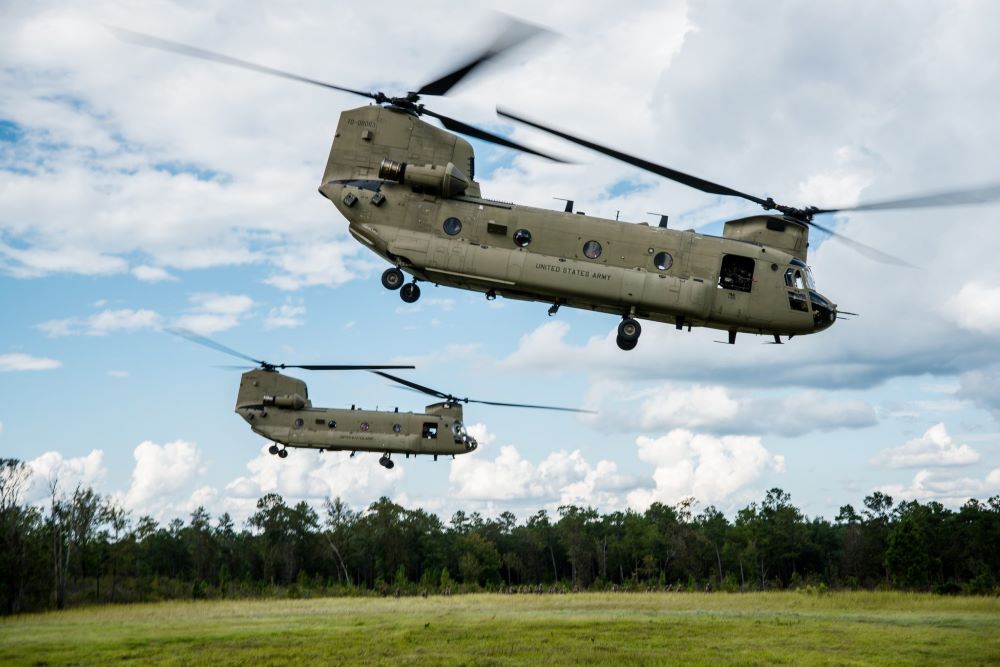
CH-47 Chinook Helicopter
asc.army.mil/web/portfolio-item/aviation_ch47f-chinook/
The CH-47F Chinook is the Army’s only heavy-lift cargo helicopter supporting combat and other critical operations. The CH-47F has a suite of improved features such as an upgraded digital cockpit featuring the Common Avionics Architecture System, a new monolithic airframe with vibration reduction, and the Digital Automatic Flight Control System, which provides coupled controllability for operations in adverse environments (reduced visibility, brown out, and high winds). The CH-47F’s common cockpit enables multiservice digital compatibility and interoperability for improved situational awareness, mission performance, and survivability, as well as future growth potential. The CH-47F Block II will provide an increased payload and operational reach beyond the existing CH-47F capabilities. The Block II will also enable the Army to better support the rapid response capability necessary for forcible and early entry contingency missions as well as tactical and operational nonlinear, noncontiguous, simulations, or sequential operations.
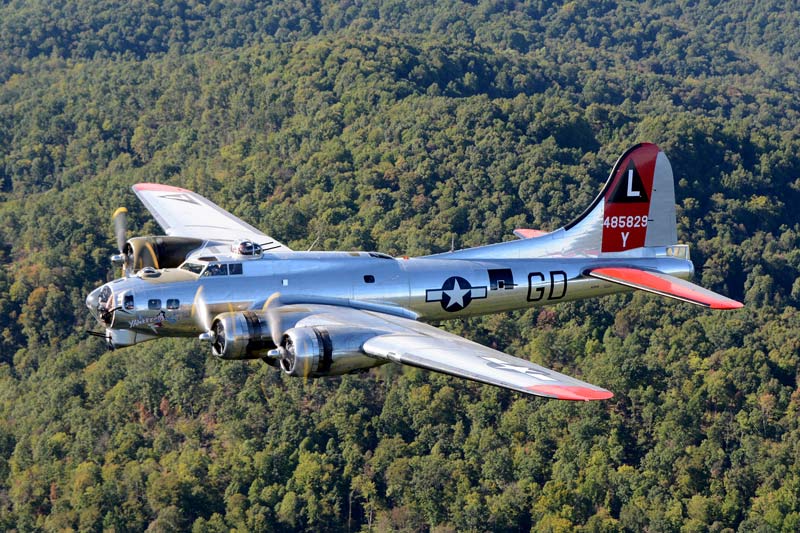
B-17 Super Fortress "Yankee Lady"
HISTORY COMES TO HOUSTON!
Yankee Lady is a Boeing B-17 Flying Fortress, owned by the Yankee Air Museum. Originally delivered to the U.S military in 1945, the plane did not see combat action; it was used by the United States Coast Guard for over a decade. Purchased by the museum in 1986, it has since been restored to a World War II configuration and is flown for flight experience rides and airshow appearances.
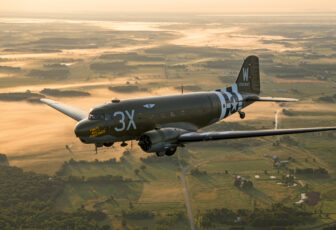
C-47 "That's All Brother"
Mission: Normandy
Over 75 years ago, on June 6, 1944, That’s All, Brother led the main airborne invasion of Normandy. Piloted by Lt. Col John Donalson, the plane led over 800 C-47s that dropped over 13,000 paratroopers into a battle that changed the course of mankind. 75 years later, we were able to bring this great airplane back to the skies over Normandy for the commemoration of the 75th anniversary of D-Day.
Nearly Lost Forever
After serving on D-Day, and in Operations Dragoon, Market Garden, Repulse, and Varsity, the airplane returned to the United States and was sold to the civilian market in 1945. During the course of many owners over the next several decades, the historical significance of the airplane was lost and it was eventually sold to be scrapped. Fortunately, two historians from the United States Air Force discovered that this historic airplane was lying in a boneyard in Wisconsin. The Commemorative Air Force was able to acquire the airplane, and through a large group of donors and volunteers, restore the airplane to flying status.
“That’s All, Brother” has been restored to its 1944 condition, including its D-Day paint scheme along with a thorough historic interior restoration. The CAF maintains airplanes to be artifacts of living history, and you can experience the airplane first hand by touring and even going for a flight.
Source/Credit: https://thatsallbrother.org/
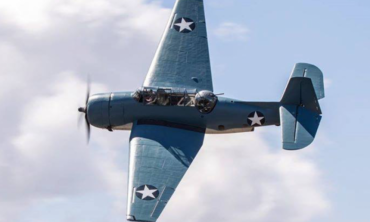
TBM-3E Avenger
lonestarflight.org/fly/general-motors-tbm-3e-avenger/
The Avenger was the largest single engine aircraft of WWII. Avengers first saw combat during the Battle of Midway in June 1942 and quickly equipped every U.S. Navy carrier operating in World War II, as well as many carriers of the British Royal Navy. Because Grumman was being pushed to produce F6F Hellcat fighters, production of the Avenger was turned over to General Motors’ Eastern Aircraft Division which built 7,546 aircraft under the designation TBM. These aircraft would go on to drop more tonnage in bombs and torpedoes than any other naval aircraft and would sink dozens of enemy ships including the Japanese super-battleships Yamato and Musashi. TBMs also accounted for 30 German and Japanese submarines as well as 98 enemy aircraft in air-to-air combat.
The key to the Avenger’s success was its versatility. In addition to its role as a torpedo bomber, TBMs were used for dive bombing, level bombing, night attack, photo reconnaissance, anti-submarine warfare, radar surveillance and light transport duties. Nicknamed the “turkey” for their slow lumbering movement and large ungainly appearance while coming in to land, the Avenger served into the mid-1950s and were supplied to allied nations such as Canada, France, England, Brazil, Japan, the Netherlands, New Zealand and Uruguay.
Info: Lone Star Flight Museum
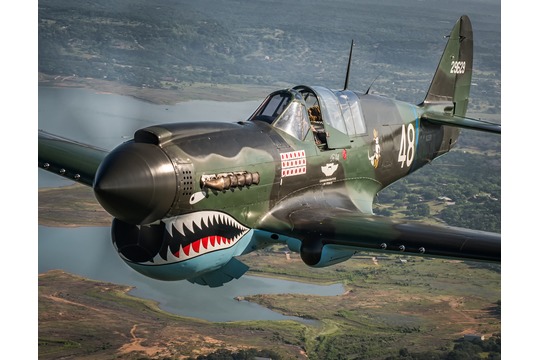
P-40 Warhawk
commemorativeairforce.org/aircraft/20
The Curtiss P-40 Warhawk is an American single-engined, single-seat, all-metal fighter and ground-attack aircraft that first flew in 1938. The P-40 design was a modification of the previous Curtiss P-36 Hawk which reduced development time and enabled a rapid entry into production and operational service. The Warhawk was used by most Allied powers during World War II, and remained in frontline service until the end of the war. It was the third most-produced American fighter, after the P-51 and P-47; by November 1944, when production of the P-40 ceased, 13,738 had been built,[4] all at Curtiss-Wright Corporation’s main production facilities at Buffalo, New York.
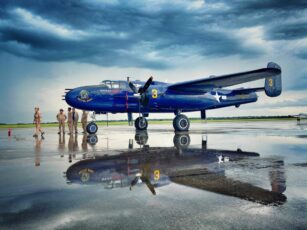
B-25 "Devil Dog"
The Devil Dog represents a PBJ-1J (the second J designates the model) of the VMB 612 squadron.
The Marines designated the B-25s “PBJ”. PB indicates Patrol Bomber and the J is an alpha-code designating the manufacturer, North American Aviation (PBJ does not mean Peanut Butter and Jelly).
The Marines were innovative in customizing the PBJs for the jobs they faced. As most of the missions were performed at low altitude, there was not much need for the glass nose/bombardier position. It was replaced with a solid nose and armed with up to 8 – .50 caliber machine guns, or in some versions, a 75mm cannon.
9 PBJ squadrons made it overseas before the war ended in the Pacific. 26 PBJs were lost in combat and 19 were lost in operational accidents while in a combat zone.
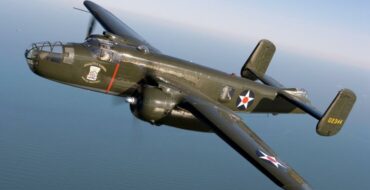
B-25 Mitchell "Doolittle Raiders" edition from Lone Star Flight Museum
lonestarflight.org/fly/north-american-b-25-mitchell/
The LSFM B-25 remained stateside during World War II and was converted into a trainer after the war for the USAF where it flew until the late 1950s. Acquired by the CIA, it flew covert missions during the Bay of Pigs invasion from Central America. Later, it would pass through several owners and was eventually restored in the late 1970s. LSFM founder Robert L. Waltrip purchased the B-25 in 1984 as the first of his collection that would serve as the basis for the Lone Star Flight Museum. Known as Special Delivery for many years, the LSFM repainted the airplane in 2007 in the colors of the Doolittle Raiders. It is the only flying B-25 painted in the colors of the Raiders and is the only civilian aircraft to feature the Doolittle Raider emblem. It is the official B-25 of the Doolittle Raider Association.
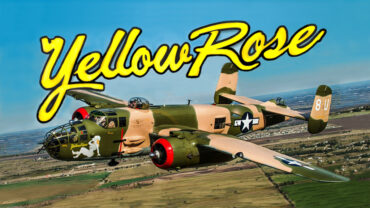
B-25 "Yellow Rose"
commemorativeairforce.org/aircraft/5
“The “Yellow Rose”, the christened name of the vintage B-25J Mitchell WWII bomber, is once again touring the American skies. The bomber is completely restored to its wartime capabilities and is operated by the Commemorative Air Force Central Texas Wing. It is one of the flying museum pieces belonging to the organization’s “Ghost Squadron” aircraft collection. After four years, the aircraft was lovingly restored to WWII condition by members of the Central Texas Wing and donated to the CAF in 1981.”
“The North American B-25 Mitchell is an American twin-engine, medium bomber manufactured by North American Aviation (NAA). It was named in honor of Major General William “Billy” Mitchell, a pioneer of U.S. military aviation. Used by many Allied air forces, the B-25 served in every theater of World War II and after the war ended many remained in service, operating across four decades. Produced in numerous variants, nearly 10,000 Mitchells rolled from NAA factories.[1] These included a few limited models, such as the United States Marine Corps’ PBJ-1 patrol bomber and the United States Army Air Forces’ F-10 reconnaissance aircraft and AT-24 trainers.”
Photo credit: Warbirdnews.com
Info credit: Commemorativeairforce.org
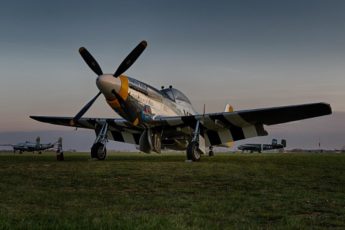
P-51 Mustang
“The North American Aviation P-51 Mustang is an American long-range, single-seat fighter and fighter-bomber used during World War II, the Korean War and other conflicts. The Mustang was designed in 1940 by North American Aviation (NAA) in response to a requirement of the British Purchasing Commission for license-built Curtiss P-40 fighters. The prototype NA-73X airframe was rolled out on 9 September 1940, 102 days after the contract was signed and first flew on 26 October.
The Mustang was originally designed to use the Allison V-1710 engine, which, in its earlier variants, had limited high-altitude performance. It was first flown operationally by the Royal Air Force (RAF) as a tactical-reconnaissance aircraft and fighter-bomber (Mustang Mk I). The addition of the Rolls-Royce Merlin to the P-51B/C model transformed the Mustang’s performance at altitudes above 15,000 ft, matching or bettering that of the Luftwaffe’s fighters. The definitive version, the P-51D, was powered by the Packard V-1650-7, a license-built version of the Rolls-Royce Merlin 66 two-stage two-speed supercharged engine, and was armed with six .50 caliber (12.7 mm) M2/AN Browning machine guns.
From late 1943, P-51Bs (supplemented by P-51Ds from mid-1944) were used by the USAAF’s Eighth Air Force to escort bombers in raids over Germany, while the RAF’s 2 TAF and the USAAF’s Ninth Air Force used the Merlin-powered Mustangs as fighter-bombers, roles in which the Mustang helped ensure Allied air superiority in 1944.[10] The P-51 was also used by Allied air forces in the North African, Mediterranean and Italian theaters, and also served against the Japanese in the Pacific War. During World War II, Mustang pilots claimed 4,950 enemy aircraft shot down.
At the start of the Korean War, the Mustang was the main fighter of the United Nations until jet fighters such as the F-86 took over this role; the Mustang then became a specialized fighter-bomber. Despite the advent of jet fighters, the Mustang remained in service with some air forces until the early 1980s. After World War II and the Korean War, many Mustangs were converted for civilian use, especially air racing, and increasingly, preserved and flown as historic warbird aircraft at airshows.”
Credit/Source:
https://en.wikipedia.org/wiki/North_American_P-51_Mustang
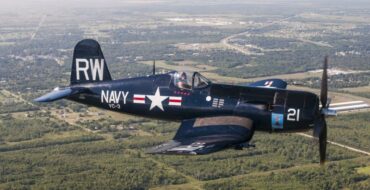
F4U-5N Corsair
lonestarflight.org/fly/chance-vought-f4u-5n-corsair/
“The Vought F4U Corsair is an American fighter aircraft that saw service primarily in World War II and the Korean War. Demand for the aircraft soon overwhelmed Vought’s manufacturing capability, resulting in production by Goodyear and Brewster: Goodyear-built Corsairs were designated FG and Brewster-built aircraft F3A. From the first prototype delivery to the U.S. Navy in 1940, to final delivery in 1953 to the French, 12,571 F4U Corsairs were manufactured, in 16 separate models, in the longest production run of any piston-engined fighter in U.S. history (1942–53).
The Corsair was designed as a carrier-based aircraft but its difficult carrier landing performance rendered it unsuitable for Navy use until the carrier landing issues were overcome by the British Fleet Air Arm. The Corsair thus came to and retained prominence in its area of greatest deployment: land based use by the U.S. Marines. The role of the dominant U.S. carrier based fighter in the second part of the war was thus filled by the Grumman F6F Hellcat, powered by the same Double Wasp engine first flown on the Corsair’s first prototype in 1940. The Corsair served to a lesser degree in the U.S. Navy. As well as the U.S. and British use the Corsair was also used by the Royal New Zealand Air Force, the French Navy Aéronavale and other, smaller, air forces until the 1960s. Some Japanese pilots regarded it as the most formidable American fighter of World War II, and the U.S. Navy counted an 11:1 kill ratio with the F4U Corsair.”
Source/Link:
https://en.wikipedia.org/wiki/Vought_F4U_Corsair
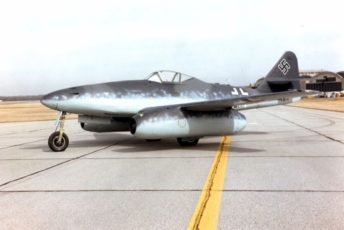
Messerschmitt Me 262 "Swallow"
“The Messerschmitt Me 262, nicknamed Schwalbe (German: “Swallow”) in fighter versions, or Sturmvogel (German: “Storm Bird”) in fighter-bomber versions, was the world’s first operational jet-powered fighter aircraft. Design work started before World War II began, but engine problems, metallurgical problems and top-level interference kept the aircraft from operational status with the Luftwaffe until mid-1944. The Me 262 was faster, and more heavily armed than any Allied fighter, including the British jet-powered Gloster Meteor. One of the most advanced aviation designs in operational use during World War II, the Me 262 was used roles including light bomber, reconnaissance and experimental night fighter versions.
Me 262 pilots claimed a total of 542 Allied kills, although higher claims are sometimes made.The Allies countered its potential effectiveness in the air by attacking the aircraft on the ground and during takeoff and landing. Engine reliability problems, from the pioneering nature of its Junkers Jumo 004 axial-flow turbojet engines—the first ever placed in mass production—and attacks by Allied forces on fuel supplies during the deteriorating late-war situation also reduced the effectiveness of the aircraft as a fighting force. In the end, the Me 262 had a negligible impact on the course of the war as a result of its late introduction and the consequently small numbers put in operational service.
While German use of the aircraft ended with the close of the Second World War, a small number were operated by the Czechoslovak Air Force until 1951. Captured Me 262s were studied and flight tested by the major powers, and ultimately influenced the designs of a number of post-war aircraft such as the North American F-86 Sabre and Boeing B-47 Stratojet. A number of aircraft have survived on static display in museums, and there have also been several privately built flying reproductions.”
Source/Link:
https://en.wikipedia.org/wiki/Messerschmitt_Me_262
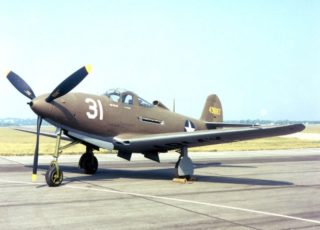
P-39 Aircobra
“The Bell P-39 Airacobra was one of the principal American fighter aircraft in service when the United States entered World War II. The P-39 was used with great success by the Soviet Air Force, which scored the highest number of individual kills attributed to any U.S. fighter type. Other major users of the type included the Free French, the Royal Air Force, the United States Army Air Forces, and the Italian Co-Belligerent Air Force.”
Credit/Source:
https://en.wikipedia.org/wiki/Bell_P-39_Airacobra
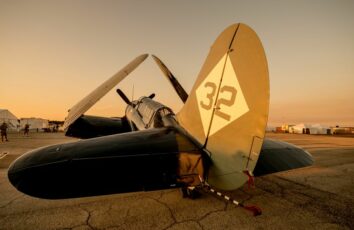
SB2C Helldiver
“The Curtiss SB2C Helldiver was a carrier-based dive bomber aircraft produced for the United States Navy during World War II. It replaced the Douglas SBD Dauntless in US Navy service. The SB2C was much faster than the SBD it replaced.
Crew nicknames for the aircraft included the Big-Tailed Beast (or just the derogatory Beast), Two-Cee and Son-of-a-Bitch 2nd Class (after its designation and partly because of its reputation for having difficult handling characteristics). Neither pilots nor aircraft carrier captains seemed to like it.
Delays marred its production—by the time the A-25 Shrike variant for the USAAF was deployed in late 1943, the Army Air Forces no longer had a need for a thoroughbred dive bomber. Poor handling of the aircraft was another factor that hampered its service introductions; both the British Royal Navy and the Royal Australian Air Force cancelled substantial orders.
The Truman Committee investigated Helldiver production and turned in a scathing report, which eventually led to the beginning of the end for Curtiss. Problems with the Helldiver were eventually ironed out, and in spite of its early problems, the aircraft was flown through the last two years of the Pacific War with a fine combat record.”
Credit/Source:
https://en.wikipedia.org/wiki/Curtiss_SB2C_Helldiver
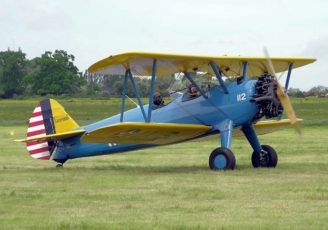
PT-17 Stearman
“The Stearman (Boeing) Model 75 is a biplane used as a military trainer aircraft, of which at least 10,626 were built in the United States during the 1930s and 1940s.[1] Stearman Aircraft became a subsidiary of Boeing in 1934. Widely known as the Stearman, Boeing Stearman or Kaydet, it served as a primary trainer for the United States Army Air Forces, the United States Navy (as the NS & N2S), and with the Royal Canadian Air Force as the Kaydet throughout World War II. After the conflict was over, thousands of surplus aircraft were sold on the civilian market. In the immediate postwar years they became popular as crop dusters, sports planes, and for aerobatic and wing walking use in air shows.”
Credit/Source:
https://en.wikipedia.org/wiki/Boeing-Stearman_Model_75
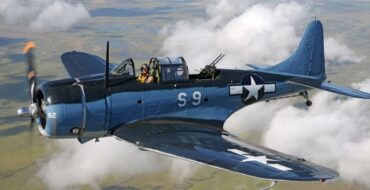
SBD Dauntless
lonestarflight.org/fly/douglas-sbd-dauntless/
“The Douglas SBD Dauntless was a World War II American naval scout plane and dive bomber that was manufactured by Douglas Aircraft from 1940 through 1944. The SBD (“Scout Bomber Douglas”) was the United States Navy’s main carrier-borne scout plane and dive bomber from mid-1940 through mid-1944. The SBD was also flown by the United States Marine Corps, both from land air bases and aircraft carriers. The SBD is best remembered as the bomber that delivered the fatal blows to the Japanese carriers at the Battle of Midway in June 1942.
During its combat service, the SBD was an excellent naval scout plane and dive bomber. It possessed long range, good handling characteristics, maneuverability, potent bomb load, great diving characteristics, good defensive armament and ruggedness. One land-based variant of the SBD — in omitting the arrestor hook — was purpose-built for the U.S. Army Air Forces, as the A-24 Banshee.”
Credit/Source:
https://en.wikipedia.org/wiki/Douglas_SBD_Dauntless
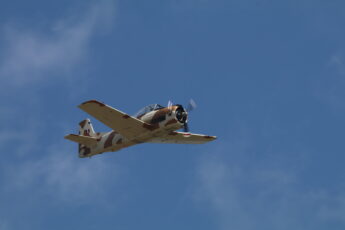
T-28 Trojan
The North American Aviation T-28 Trojan is a piston-engined military trainer aircraft used by the United States Air Force and United States Navy beginning in the 1950s. Besides its use as a trainer, the T-28 was successfully employed as a counter-insurgency aircraft, primarily during the Vietnam War. It has continued in civilian use as an aerobatics and Warbird performer.
Source/Credit:
https://en.wikipedia.org/wiki/North_American_T-28_Trojan
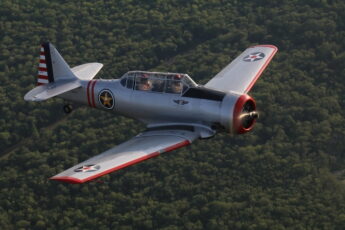
T-6 Texan
“The North American Aviation T-6 Texan is a single-engined advanced trainer aircraft used to train pilots of the United States Army Air Forces (USAAF), United States Navy, Royal Air Force, and other air forces of the British Commonwealth during World War II and into the 1970s. Designed by North American Aviation, the T-6 is known by a variety of designations depending on the model and operating air force. The United States Army Air Corps (USAAC) and USAAF designated it as the AT-6, the United States Navy the SNJ, and British Commonwealth air forces, the Harvard, the name by which it is best known outside of the US. After 1962, US forces designated it the T-6. It remains a popular warbird aircraft used for airshow demonstrations and static displays. It has also been used many times to simulate various Japanese aircraft, including the Mitsubishi A6M Zero in movies depicting World War II in the Pacific.”
Source/Credit:
https://en.wikipedia.org/wiki/North_American_T-6_Texan
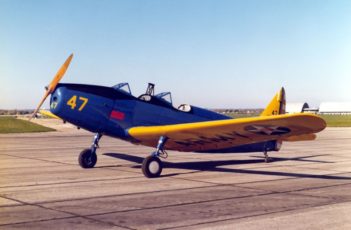
Fairchild PT-19
“The Fairchild PT-19 (company designation Fairchild M62) is an American Fairchild Aircraft monoplane primary trainer aircraft that served with the United States Army Air Forces, RAF and RCAF during World War II. It was a contemporary of the Kaydet biplane trainer and was used by the USAAF during Primary Flying Training as the introductory pre-solo phase trainer for introducing new pilots to flying before passing them on to the more agile Kaydet. As with other USAAF trainers of the period, the PT-19 had multiple designations based on the powerplant installed.”
Source/Credit:
https://en.wikipedia.org/wiki/Fairchild_PT-19
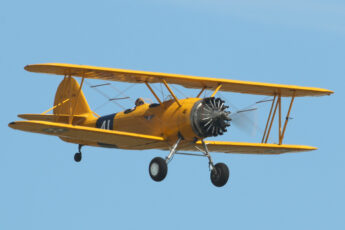
Naval Aircraft Factory N3N
The Naval Aircraft Factory N3N was an American tandem-seat, open cockpit, primary training biplane aircraft built by the Naval Aircraft Factory (NAF) in Philadelphia, Pennsylvania, during the 1930s.
Source/Credit:
https://en.wikipedia.org/wiki/Naval_Aircraft_Factory_N3N
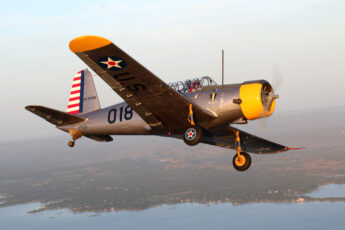
BT-13 Valiant
The Vultee BT-13 Valiant was an American World War II-era basic trainer aircraft built by Vultee Aircraft for the United States Army Air Corps, and later US Army Air Forces. A subsequent variant of the BT-13 in USAAC/USAAF service was known as the BT-15 Valiant, while an identical version for the US Navy was known as the SNV and was used to train naval aviators for the US Navy and its sister services, the US Marine Corps and US Coast Guard.
Source/Credit:
https://en.wikipedia.org/wiki/Vultee_BT-13_Valiant
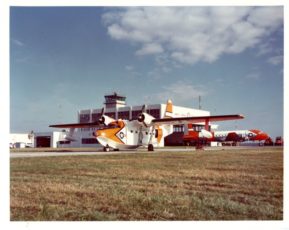
HU-16 Albatross
The Grumman HU-16 Albatross is a large twin–radial engine amphibious flying boat that was used by the United States Air Force (USAF), the U.S. Navy (USN) and the U.S. Coast Guard (USCG), primarily as a search and rescue aircraft. Originally designated as the SA-16 for the USAF and the JR2F-1 and UF-1 for the USN and USCG, it was redesignated as the HU-16 in 1962.
Source/Credit:
https://en.wikipedia.org/wiki/Grumman_HU-16_Albatross
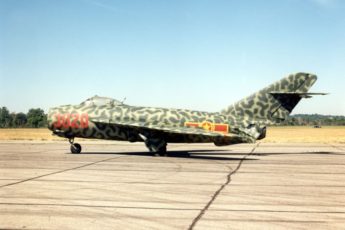
MiG-17 Fresco
“The Mikoyan-Gurevich MiG-17 (Russian: Микоян и Гуревич МиГ-17) (NATO reporting name: Fresco) (China:Shenyang J-5) (Poland: PZL-Mielec Lim-5)[1] is a high-subsonic fighter aircraft produced in the USSR from 1952 and operated by numerous air forces in many variants. It is an advanced development of the very similar appearing MiG-15 of the Korean War.
The MiG-17 first saw combat in 1958 over the Straits of Taiwan and was used as an effective threat against supersonic fighters of the United States in the Vietnam War. It was also briefly known as the Type 38, by U.S. Air Force designation prior to the development of NATO codes.
Source/Credit:
https://en.wikipedia.org/wiki/Mikoyan-Gurevich_MiG-17
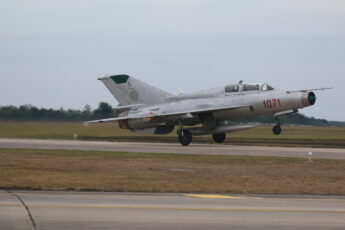
MiG-21 Fishbed
“The Mikoyan-Gurevich MiG-21 (Russian: Микоян и Гуревич МиГ-21; NATO reporting name: Fishbed) is a supersonic jet fighter aircraft, designed by the Mikoyan-Gurevich Design Bureau in the Soviet Union. It was popularly nicknamed “Balalaika”, from the aircraft’s planform-view resemblance to the Russian stringed musical instrument or ołówek (English: pencil) by Polish pilots due to the shape of its fuselage.
Early versions are considered second-generation jet fighters, while later versions are considered to be third-generation jet fighters.[citation needed] Approximately 60 countries over four continents have flown the MiG-21, and it still serves many nations six decades after its maiden flight. The fighter made aviation records. At least by name, it is the most-produced supersonic jet aircraft in aviation history and the most-produced combat aircraft since the Korean War, and it was previously the longest production run of a combat aircraft (now exceeded by both the McDonnell Douglas F-15 Eagle and General Dynamics F-16 Fighting Falcon).”
Credit:
https://en.wikipedia.org/wiki/Mikoyan-Gurevich_MiG-21
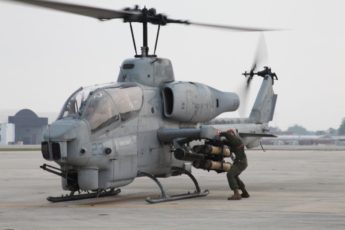
AH-1 Cobra
“The Bell AH-1 Cobra is a two-blade, single engine attack helicopter manufactured by Bell Helicopter. It was developed using the engine, transmission and rotor system of the Bell UH-1 Iroquois. A member of the prolific Huey family, the AH-1 is also referred to as the HueyCobra or Snake.
The AH-1 was the backbone of the United States Army’s attack helicopter fleet, but has been replaced by the AH-64 Apache in Army service. Upgraded versions continue to fly with the militaries of several other nations. The AH-1 twin engine versions remain in service with United States Marine Corps (USMC) as the service’s primary attack helicopter. Surplus AH-1 helicopters have been converted for fighting forest fires.”
Credit:
https://en.wikipedia.org/wiki/Bell_AH-1_Cobra
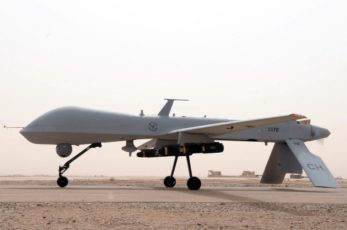
MQ-1 Predator
The General Atomics MQ-1 Predator is an American remotely piloted aerial vehicle (RPA) built by General Atomics and used primarily by the United States Air Force (USAF) and Central Intelligence Agency (CIA). Initially conceived in the early 1990s for aerial reconnaissance and forward observation roles, the Predator carries cameras and other sensors but has been modified and upgraded to carry and fire two AGM-114 Hellfire missiles or other munitions. The aircraft, in use since 1995, has seen combat in war in Afghanistan, Pakistan, the NATO intervention in Bosnia, Serbia, Iraq War, Yemen, Libyan civil war, the intervention in Syria, and Somalia.
The USAF describes the Predator as a “Tier II” MALE UAS (medium-altitude, long-endurance unmanned aircraft system). The UAS consists of four aircraft or “air vehicles” with sensors, a ground control station (GCS), and a primary satellite link communication suite.Powered by a Rotax engine and driven by a propeller, the air vehicle can fly up to 400 nmi (460 mi; 740 km) to a target, loiter overhead for 14 hours, then return to its base.
Credit/Source:
https://en.wikipedia.org/wiki/General_Atomics_MQ-1_Predator
